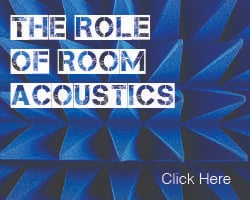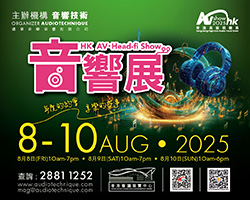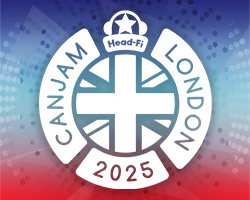Having just recovered from listening to the amazing binaural Espana and Mozart offerings from Chasing The Dragon – yes, they really are that good especially in vinyl form – Janine Elliot was invited back to Air Studios for what was yet another great production from the duo of Mike and Francoise Valentine.
Their latest venture was a mean musical meal of strings, harpsichord, guitar and harp performed by the Locrean Ensemble of London, playing some of my most loved works, including Vivaldi Guitar Concerto with soloist Morgan Szymanski, Handel’s Harp Concerto (first and last movements) with soloist Jean Kelly, Vivaldi’s Sinfonia alla Rustica, and some old favourites; Pachelbel’s Canon and the Rondo from Mozart’s Eine Kleine Nachtmusik. I love 17th-18th century Baroque and early Classical music, a period when works had to be very precisely played – no appassionato, so no playing around with speed or sentiment, just as I don’t want my hifi to, either. For perfection of music composition one would hope for a similarly perfect replay source and Mike has made sure of this by offering this foremost as a direct cut disc binaural with 24bit/192kHz WAV and CD as secondary options. Therefore this album claims to be “The World’s first Binaural Direct Cut Recording” a title proudly written at the top of the record.
With four first violins, three second violins, two violas, one cello and bass, plus harpsichord, this was a well formed consort of instrumentalists. Whilst the harpsichord and instruments were not antique themselves (the harpsichord made by Wooderson of London), it was good to go back to some basic antiquity of recording method, performing directly onto a vinyl master, using the best cutting lathe, the Neumann VMS 80, and the skills of cutting engineer John Webber. My mother was proud that she once sang on an old 78rpm disc in her teens back in the real dark (shellac) ages of recording. I am not sure how many copies were made from that master, but it still plays well on my wind-up gramophones. Being recorded “as live” did mean this Valentine recording entrusted the musicians to perform to their best, though any mistake in performance just added to the lifelike sound obtained from Binaural itself. The fact there were the occasional blemishes in performance just made it all the more real. As a child I used to prefer to listen to live performances of classical music on BBC Radio 3 rather than the LPs they played, and no matter how good the Studio Managers edited retakes of sections of recording sessions at Maida Vale to create that “perfect” final take, it never sounded as live as a live performance could.
We were booked in Air Studio 1, London for the half day, so time was of the essence to get the best performances of the works, allowing just two chances of playing through each “side”, and choosing the best performance. Each acetate master costs £50, meaning that even a one-take wonder would cost £100 for the two sides of the LP. Mike terminated one live recording midway due to some wrong notes from the harp mid solo, something no studio manager would have been able to rectify whatever technology was being used, and this allowed extra time to get a choice of two good performances of each side of the album, before our clocking off time at 1pm.
I was in familiar territory being in the same studio as earlier Chasing the Dragon recordings. The analogue Neve desk in Studio 1 is similar to the (later) Neve 66 desks festooned in the basement of “old” BBC Broadcasting House back in the 90’s that I lovingly used on a daily basis. This desk is one of three unique Neve consoles designed solely for Air Studios. The first of the consoles designed in 1977 was for Air’s new facility on the Caribbean island of Montserrat, a studio surviving until Hurricane Hugo destroyed 90% of the island in 1989. The other two desks were based in London with one now residing in Studio 1 at Lyndhurst Hall, Hampstead, which was opened in 1992. The legendary Beatles producer and founder of Air Studios, George Martin (1926-2016) was heavily involved with Rupert Neve in the design process of what was a radical new desk at the time, and with toroidal wound transformers, instead of the standard audio Neve transformers, this gave a better sound, just as toroidal transformers are favoured by many audiophiles, especially me. In the recording of Binaural Baroque, that aim for audio excellence continued in the recording process; just a stereo Neumann BU-100 dummy head and a U47 spot microphone for the guitar, fed to the desk channel with direct fader outputs which is the cleanest path into all the recorders, meaning missing group faders. 
The intention of this recording was of doing something new as well as the ultimate in quality and musicality, as Mike explained,
“This is the very first binaural direct cut disc; basically, we are always trying to do something new. So I thought, well, how about the binaural head that we have been using recently and love; why not use that as the source for a direct cut disc? I don’t think anyone has done a binaural direct cut. So we thought, well, why not get the Locrian Ensemble together and play some lovely Vivaldi and Handel, and well, call it “Binaural Baroque”.
As well as feeding the vinyl, direct outputs were distributed to Mike’s Nagra VI for 24/192 WAVs and a Tascam DA3000 to record to DSD. That gave me the chance to compare all three options. As we speak, vinyl and WAV digital options are available on their website, but it might not just end there, as Mike told me; “Eventually I may release a master tape as well”. Mike is investing in purchasing more reel to reel recorders to make probably the World’s first Binaural by reel to reel option available in the future. Whilst vinyl was the objective of the session, this album should cater for all audiophile needs.
I asked Mike about the positioning of the BU-100 mannequin, which was positioned about 5ft above and 2ft behind where a conductor would have stood.
“It has gone back to the old way of recording where you would have a microphone in the studio and if the trumpets in your jazz band were too loud you’d move them further back, and if you’ve got one trumpet solo you would bring him physically forward. The secret of binaural recording is finding that perfect place for the head”. Mike explained how he moved the head forward but lost some of the overall sound of the orchestra and so after a few adjustments found that optimal position. As a sound engineer I always favoured minimal, purist use of microphones, based around the use of a coincident pair of cardioids, something that even Deutche Grammophon are offering on their latest Berliner Philharmoniker Sir Simon Rattle recording of the Beethoven Symphonies, as an alternative to their multi-microphone version, both in the same 10 disc 180g package. Of course such purist take can cause mismatch of some of the quieter instruments, and during setting up for the Binaural Baroque recording I had wondered if the harpsichord, placed at the rear of the consort, would be somewhat lost by the two microphones in the mannequin’s ears being so far way. But listening during recording I found the balance with the other instrumentalists was spot on, even with the conversational playing between guitar and harpsichord at front and back of the soundstage, respectively. Only in the harp concerto did I feel slightly overwhelmed by the soloist at the front, though the harpsichord was still very audible. Indeed that BU-100 is very magical in picking out everything. Who says you actually need a mixing desk and 40 microphones;
“What I am amazed by with this head is it seems to pick up everything. We try to get things as natural as we can possibly get them. Sometimes when you have a quiet instrument, like the guitar, we needed to use a spot-mic; a U47. But because he is mono and centre stage having a little microphone doesn’t affect the phase or wonderful stereo qualities of the binaural mix. It just adds a tiny bit of clarity”. And boy did it work well. Listening on Stax SR-009 Earspeakers, kindly donated by Nigel Crump from Symmetry, I was placed in audio heaven, much preferring monitoring through these cans than through the studio’s nearfield B&W 805’s sitting on the Neve desk. With sound engineering in my blood I made sure I first heard the musicians in the studio before monitoring in the control room, and the nearest sound to the original was undoubtedly wearing the Stax, creating a very real 3D soundstage. The only limiting effect of ‘binaural’ in this recording is the fact that the depth and detail of soundstage is smaller than would be for a large multi-membered orchestra – as in the gigantic Espana recording. With less instruments and a smaller stage, this recording is more intimate and personal, but no less exciting and mesmeric. 
Back home, having downloaded the final album as 24/192WAV I started listening in the comfort of my own living room through my own lowly Stax SR-407’s the reality and life and dynamism of the studio recording came through with aplomb. My first move was to change my 3.5mm to RCA lead; the sound was very forward mid-band and totally unlike what I heard on the day. Who says cables don’t make a difference. Once I connected a favoured monocrystal cable I was back in Studio 1. What is noticeable in the recording is the clarity from all instruments and the clear and smooth velvety sound from harpsichord that was just the right level as I heard in the studio; not too quiet or distant as I often hear on “conventional” recordings. Indeed, I was surprised just how good it all sounded; whilst the harpsichord was very audible it wasn’t over bright, or even too loud! It just sounded like I would have heard it if my own head had been winched up 10’ on the BU-100’s mic stand. Only the strings – particularly first violins – sounded slightly drier than I would like, though they sound as natural as they would if I were placed exactly where the mannequin was. We are so used to overzealous Classic-FM type reverb that sounds very lovely but not realistic. In Vivaldi’s Guitar Concerto the guitar was very clear and forward, that I could almost reach out and touch the strings. Perhaps slightly more from the TC Electronics reverb would have made it more heavenly, but then the closeness – particularly – from the violins would have made the music imbalanced. This was not a dry performance, only that the acoustics were clean, as if we were listening close to the musicians as they would have done in Baroque times. Whilst Mike – and I – would have liked to have recorded it at a monastery or a beautiful church, as might religious music of the period have been played, having used Air Studios before and the fact that it comes complete with the Neumann VMS80 vinyl lathe made it the obvious choice. Once Jean Kelly let rip from her harp, that reverberation from the instrument opened up the sound immensely – imagine a pianist playing whilst holding down the damping pedal – increasing overall bass response and “3D” depth of sound, working extremely well in a binaural context. So many conventional multi-mic’d recordings make the sound claustrophobic and cluttered. This was so good I didn’t want to switch off listening and go to bed. Jean’s performance – the second take of this second half of the album – was perfection, only one note plucked with slightly too much enthusiasm in the final movement. Whilst she was very loud she wasn’t overpowering. Indeed in the guitar concerto the conversations between the harpsichord and guitar were not only timed to perfection but also the levels worked perfectly despite the keyboard actually sitting 10 feet further back! Vivaldi’s Sinfonia alla Rustica is perhaps the least familiar work, one that is highly complex in its contrapuntal writing, and the binaural head helps pick out all the individual lines of music much clearer than I have heard on many a conventional recording. The highlight for most will be Mozart’s Eine Kleine Nachtmusik. OK, Baroque it may not be but this 1787 work, written around the same time as his opera Don Giovanni, fits perfectly with others in this recital. Originally labelled as ‘Serenade Number 13 in G’ rather than “A Little Night Music” it never actually saw the light of day until Mozart was dead and his wife Constance had published it. We are therefore very indebted to her, as well as The Locrean Ensemble for their take on the final fourth movement, the Rondo. The work was written for string quartet with added double bass, and originally had five movements, but one of these has been lost. The performance on this disc is well played and is a fine ending to this binaural baroque bonanza. Actually, it isn’t Mozart having the final word in this album; that privilege goes to Mike Valentine at the end of the Rondo entering the studio stage left to congratulate the performers and send them on their way, whilst the VMS 80 lathe was still busily etching away, and which sounds absolutely magical on headphones, especially with the musicians applauding their performance. Whether intentional or not this encore was a magical addition to the album, especially for binaural lovers, like myself. As a child I dabbled in recording binaural using two Crown PZM microphones back to back with a large sheet of card between, recording conversation and noises as well as music. Mike’s entrance at the at the work’s exit is just as magical and just as entertaining as the music!
Janine Elliot








































































































































































































You must be logged in to leave a reply.